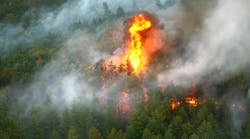STOWE, VT - June 14, 2011 — Utility Risk Management Corporation (URMC) reported today that a character evaluation conducted at the Electric Power Research Institute (EPRI) confirmed its new thermal sensor, Thermal Directâ„¢, can accurately measure transmission line temperatures when utilized across a broad spectrum of conductors and field conditions.
“The completion of this third party, blind, scientific test empirically establishes that conductor temperature needs no longer be estimated,” said Adam Rousselle, CEO of URMC. “This revolutionary technology will benefit the industry and consumers by more precisely defining capacity and congestion within the transmission system, assist in locating more efficient pathways from generation to the consumer load zones and reduce the cost of the fuel used to create the power itself. The most exciting aspect is that the technology is founded in empirical mathematics. The technology is transparent, accurate and timeless.”
During controlled outdoor testing at EPRI's High-Voltage Laboratory in Lenox, Massachusetts, Thermal Directâ„¢ measurements were compared to EPRI line monitors. Thermal Directâ„¢ was able to measure the conductor temperature with root mean squared error (RMSE) below 5 degrees C when conductor temperature varied in a range typical to operating transmission lines. All EPRI and URMC measurements were kept separated until the completion of each test series, and the results do not represent an EPRI endorsement of Thermal Directâ„¢.
Dale Douglass, Principal Engineer at Power Delivery Consultants, who witnessed the tests, noted that the direct measurement of conductor temperature can eliminate the need for subsequent clearance checks of questionable spans by ground survey crews. He also noted that direct measurement of conductor temperature at multiple points between dead-end structures should lead to more accurate high-temperature sag calculations with numerical line design programs such as PLS-CADD.
"The fact that Thermal Directâ„¢ measurements of conductor temperature were either equal to or slightly less than EPRI measurements is encouraging as it will result in a mildly conservative estimate of line clearance at maximum temperature," Douglass said. “Thermal Directâ„¢ appears to be a viable alternative to more complex calculation methods that require precise measurement of weather conditions and knowledge of line current at the time of the survey."
The scientific tests assessed the impact of various factors, including: conductor emissivity, conductor temperature, conductor size, and local environmental conditions. Using Thermal Directâ„¢ equipment mounted to a helicopter, URMC scanned sample spans, representing a wide variety of conductor types and provided temperature readings by time, span and probe. The conductor temperatures were established by controlling the current through the conductor. The circuits flown were monitored at discrete points by EPRI RF temperature sensors attached to the conductors.
The initial evaluation of test results demonstrate that Thermal Directâ„¢ has the ability to replace complex and cumbersome data collection with a simplified process that relies on direct measurement along many points on the line.
"Though a more thorough analysis and documentation process is underway, and will be reported by EPRI later this month, we were excited to get these initial results to the transmission community," Rousselle said.
As overhead transmission lines age and sag, they must be designed and operated to assure public safety while undergoing a wide range of power flows and environmental conditions. The ability for Thermal Directâ„¢ to accurately measure line temperatures will assist utilities with the conservative, long-term approach required for grid reliability and efficiency.
About URMC
Founded in 2005, URMC is a technology-enabled engineering services firm providing vital information and analytics to electric utilities in order to safeguard and optimize their transmission and distribution infrastructures. URMC is a proven innovator in the field of risk management, consistently delivering high value and innovative technologies that cater to the electric utility industry's unique mission-critical needs. URMC harnesses disparate technologies and processes – such as Light Detection and Ranging (LiDAR), Infrared Thermography, Satellite Imagery, Power Line Systems Computer-aided Design and Drafting (PLS-CADD) modeling, and Geographic Information Systems (GIS) – to provide utility-specific analysis and solutions with unprecedented depth, accuracy and speed. URMC arms the utility industry with critical insights into areas such as vegetation encroachment, survey point clearance, sag and tension limits, thermal line ratings and line capacity.
Available to speak on the validity of the test's data and the significance of this breakthrough:
Contact:
Lucy-Claire Saunders, (212) 681-1380

